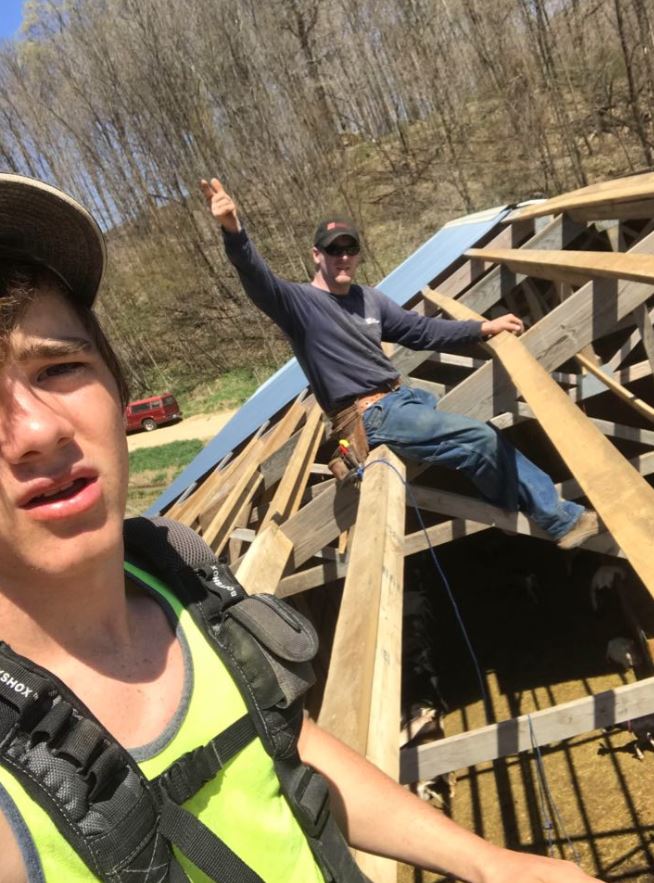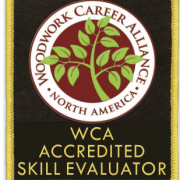COVID Can’t Stop Woodworking Students from Learning and Earning

Josiah Pole, a student at Boyceville High School in Boyceville, WI, gets some hands-on experience helping his dad build a shed.
A survey by the Woodwork Career Alliance reveals the unique challenges and ingenuity of teaching woodworking online and the determination of many students to earn their WCA credentials.
NELLYSFORD, Va. — The novel coronavirus pandemic forced the vast majority of schools across the United States and Canada to abruptly shut down for the remainder of the academic year and pivot to a crash course of online learning.
In spite of losing access to hands-on instruction, 179 students representing 13 high schools and postsecondary schools managed to earn their credentials, including Sawblade Certificates or Green or Blue Passport credentials, by successfully taking the Woodwork Career Alliance of North America’s (WCA) online credentialing test. All of these students were fortunate to have completed their machine operating evaluations before most states mandated schools to close to slow the spread of COVID-19.
Some of the instructors whose students attained their credentialswere among the WCA EDUcation members who participated in a survey conducted by the WCA. The survey sought to learn how high school and postsecondary woodworking instructors throughout the United States and Canada met the challenges of transitioning to teaching their students online including what types of information they taught in the absence of hands-on woodworking instruction.
The survey also asked teachers what resources they had developed or tapped into, including those available online to WCA EDUcation members. Their collective responses revealed the use of a wide assortment of educational tools including everything from assigning YouTube woodworking videos and home maintenance projects to quizzes on School.net and having woodworking students assemble UGears laser cut models. Among the WCA resources that were tapped include woodworking videos produced by Patrick Molzahn of Madison College, Fine Woodworking articles and videos and past state SkillsUSA project drawings.
The majority of teachers cited the challenge of transitioning online with very short notice, especially under the pressure of a global pandemic. Yet, many were able to relate silver linings gained from the experience.
“I think that one of the big positives that came out of all this is that although we were kicked out of the classroom, we still got kids certified with the Sawblade certificate and that’s sort of a neat thing,” said Scott Bruening, tech teacher at Kettle Moraine High School of Wales, WI. “We made lemonade out of lemons. That’s all we could do. Another good thing is that we got a crash course of doing things with online learning technology that could become the norm in the next five or 10 years.
Molly Turner, woodworking instructor at Ignacio School District of Ignacio High School, said it was challenging to engage students online, especially considering that woodworking is an elective course. “(N)o no one had time to prepare, plan or transition smoothly into homebound learning. It happened so quickly… On the plus side, it’s broken down some of the barriers of distance and forced everyone to become fluent in technologies that have been out there for a while, but maybe not used extensively prior to COVID-19: Zoom, Google Hangouts, Google Classroom, etc.”
“If there is any upside to this it will be that we are developing more teaching materials and expertise that will allow our students to work in a more independent and self-directed way: whether on a computer in our facility or at home,” said Doug Rappe, lead technical instructor of the Greater West Town Community Development Project of Chicago. “I am sure that some of the work we are doing in Google Classroom will be put to use for future classes for instance so that a student who needs extra review or misses a class can work on his or her own to catch up.”
Roger Peterson, woods instructor at Hurley High School District of Hurley, WI, said in an alternative to hands-on woodworking instruction, he assigned students “around the house” projects. “This is a challenging time and when students see everyone working together to get through this … THAT is what they are truly learning!”
“Hats off to all of the teachers and students who persevered during an extraordinarily challenging finish to the school year,” said Scott Nelson, president of the WCA. “Teaching woodworking online is less than ideal. That’s why I was s impressed by the creativity and resourcefulness that was demonstrated, including those who were able to complete the requirements for their Sawblade certificates and Passport credentials. I’m also extremely pleased that several of the instructors offered videos and documents they produced for the WCA to add to its online resource library to share with other woodworking instructors.”
Read the WCA’s COVID-19 survey report.
About the Woodwork Career Alliance
The Woodwork Career Alliance of North America was founded in 2007 as a 501(c)(3) non-profit corporation and is governed by a volunteer board of directors. The WCA’s mission is to develop and administer a unified set of Skill Standards for the wood products industry. Since 2011, WCA has developed observable and measurable performance standards and assessments for more than 300 woodworking machine operations. In addition, WCA has issued more than 2,500 credentials, a portable, personal permanent record documenting each holder’s record of woodworking skill achievements. More than 130 high schools and post-secondary schools throughout North America are WCA EDUcation™ members and a growing number of woodworking companies have joined the WCA as MANufacturing™ members. To learn more about the WCA and how to get involved with its programs, including sponsorship opportunities, visit WoodworkCareer.org.






Leave a Reply
Want to join the discussion?Feel free to contribute!